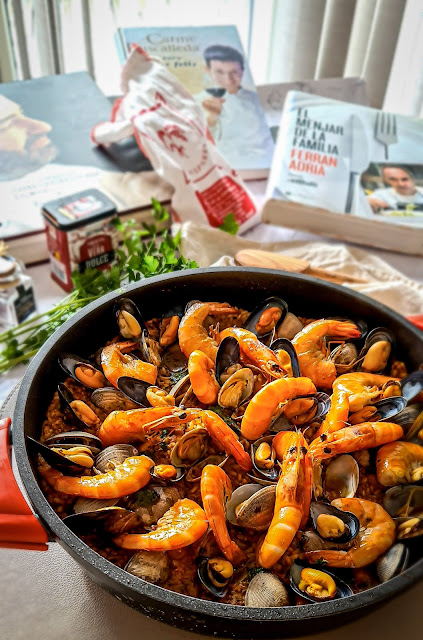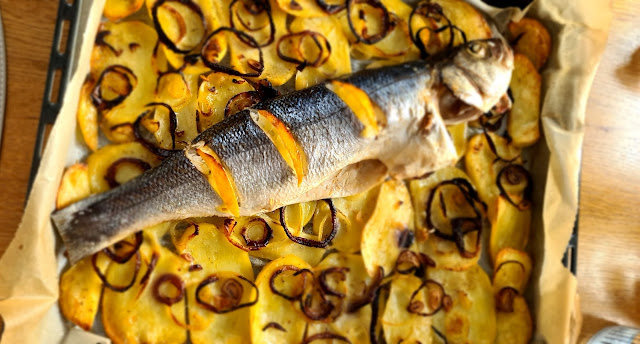My Seafood Paella
My Seafood Paella
This recipe was, without a doubt, the first idea I had in my mind when I took part in a cooking challenge organized by @chefchrissheppard called 'From The Sea' for The Brigade Cooking Challenge. A Cooking platform created with the idea of sharing the love for food and taking part in fantastic challenges for all the members.
I was lucky enough to win the challenge!!
With this recipe I'd like to explain step by step the process of cooking a good paella.
Why is important to choose a good variety of Spanish rice?
There is always a lot to talk about when it comes to cooking a Paella in Spain, where I am from. Maybe the debate is about what type of rice you can use or maybe it's about what the main ingredients are. Perhaps you are thinking that a Paella is always cooked with chicken, prawns and some vegetables - let me tell you that this is not particularly right, you can use any ingredient you'd like, the possibilities are endless.
The truth is that when you intend to cook a Paella, the first thing I would recommend is to try using high-quality main ingredients and always use a type of rice called 'Arroz Bomba', which comes from the Spanish region of Valencia. For this recipe I used one called 'arroz bomba Calasparra', a variety of rice from the region of Murcia.
This rice has a high culinary quality, which makes it perfect for cooking paella, as all you need is for the rice to absorb the flavours coming from the 'sofrito' and the stock. The rice grains need to stay whole and not stick. Nowadays, it is quite easy to find it in big supermarkets, food specialty stores and or just find it known as 'Spanish rice', easy to remember, don't you think?
Now let's talk about the ingredients you can use for making a lovely paella. For starters, I would say that the most common is a Seafood Paella. Here you can experiment with cuttlefish, calamari, clams, mussels, prawns, crab food, lobster, and many more beautiful seafood creatures, like an octopus.
There is also the option to go the easy way with a chicken and prawn paella. Or you can go crazy and use another type of meat, like Iberian cheek, pork ribs, or sausages. I love a vegetable paella too, my favourite one is using artichokes, tender green beans, and forest mushrooms, again use your imagination and experiment!
Time to cook foodie fellas!
What do you need:
✅ Paella pan 32cm
✅ Stockpot
✅ Pestle and mortar
✅ Chef knife and paring knife
✅ Gratter coarse
Ingredients for 4:
✔ 100g Virgin Olive Oil 'AOVE'
✔1 medium Onion
✔1 Garlic
✔3 medium ripe tomatoes, grated
✔1 tsp pimentón de la Vera or smoked paprika
✔20ml Infused saffron
✔About 400g of cuttlefish or calamari
✔150-200g Raw whole prawns
✔400g Bomba rice or Spanish rice
✔1.4l Fish stock (you can either cook it in advance or buy ready-made from your fishmonger)
✔️Aprox. 200gr Fresh Mussels
✔️Aprox. 200gr Fresh Clams
Method:
1st Step - Make a quick fish stock:
Ingredients:
1 onion chopped, 1 leek chopped, 1-2 carrots chopped, 1 riped tomato, fish bones, use if possible, the heads of the prawn to add intense flavours, AOVE, bay leaf, some parsley, and water.
Method:
- Sauté the chopped vegetables into a big stockpot for about 3 minutes.
- Add the fish bones and the heads of some of the prawns (reserve some more to add at the end).
- Smash the shellfish a bit so the prawns release their intense reddish liquids.
- Add about 2 l of hot water and cook for 20 minutes.
- Remove the foam with a skimmer during cooking. Strain and Reserve. Keep it warm.
2nd Step - Clean and Cook the Clams and Mussels:
- Remove the clams from the bag and let them soak in salted water to release some impurities or sand they may have. Discard any clam that has already opened. Only keep the ones that are closed. Keep them like this until time to use them or in the fridge.
- Clean the mussels under the tap with water, remove the beards with a paring knife, and discard any broken or opened mussels. Just keep the well-closed ones.
- Heat about 200ml of water into a big saucepan or stock pot and add the Mussels. Cook about 6-8 minutes until they are opened, and keep some of the cooked water to add it to the paella later on.
3rd Step - Starting to cook the Paella:
'Sofrito'
- Sauté the prawn tails and raw prawns with some AOVE (Virgin Olive Oil) into a hot paella pan for about 2 minutes until it changes colour. Remove and reserve.
- In the same oil, cook at medium temperature 1 whole garlic and add finely chopped onion. Cook until brown and caramelized. Carefully remove the sofrito to the sides of the paella and leave some free space in the middle to continue cooking the rest of the ingredients.
- Prepare the infused saffron at this point by making a small flat packet with a piece of kitchen foil wrapping the saffron threads. Toast this packet for just 2 min in the pan and remove. Open it and crush the saffron threads using a pestle and mortar. Add 2 tbsp of the fish stock and mix well. Reserve for later.
- Increase the heat and add the cuttlefish or the calamari, once cleaned and chopped into easy-to-eat pieces (to make your life easier, ask your fishmonger to clean and chop it for you). Cook until it's done.
- At this point, we add smoky flavours, Pimenton de la Vera, or Paprika, cook for 10 seconds quickly, or it can burn quite easily. Add the grated tomato afterward. and cook for 4- 5 minutes until it's reduced and caramelized.
4th Step - Cooking the rice:
- Add the rice into the sofrito and stir so it incorporates well with all the ingredients. Meanwhile, heat up the fish stock.
- Add the fish stock and about 100ml of mussels broth, when it's really hot, into the paella pan and cook for about 18 - 20 minutes. Add the infused saffron and also all the clams once the broth starts to bubble.
- Incorporate nicely around the paella pan the prawns and mussels we cooked and reserved at the beginning of the last 2 minutes of cooking time.
- The cooking time of the paella is usually 10 minutes at high heat and 8 minutes at low heat.
- The last 2 or 3 minutes must be covered and rest a little.
See this quick video reel to follow the process:
Enjoy! And feel free to add any comments. I'd love to read them.
Esther

.jpg)



Comments
Post a Comment